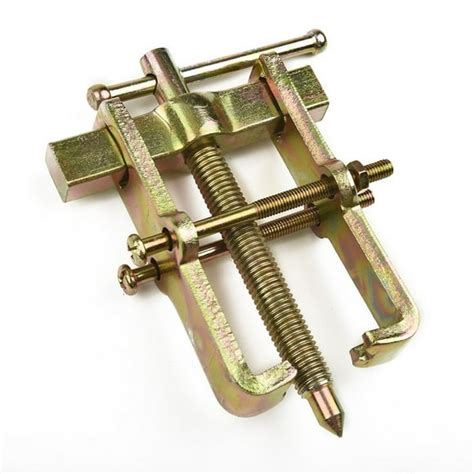The Essential Guide to Needle Bearing Pullers: A Comprehensive Overview
Introduction
Needle bearings are essential components in various industrial applications, ranging from automotive engines to robotics and medical devices. These bearings provide high load capacity, low friction, and extended life in demanding operating conditions. However, replacing or inspecting needle bearings often requires specialized tools, such as needle bearing pullers.
This comprehensive guide delves into the intricacies of needle bearing pullers, exploring their types, applications, and best practices for effective usage. By understanding the principles and techniques involved in needle bearing pulling, you can ensure efficient and safe maintenance of your equipment.
Types of Needle Bearing Pullers
1. Hydraulic Pullers:
- Hydraulic pullers utilize hydraulic pressure to generate force for bearing removal.
- Offer high pulling capacity and precise control.
- Suitable for heavy-duty applications where significant force is required.
2. Mechanical Pullers:
- Mechanical pullers employ a lever and cam mechanism to extract bearings.
- More compact and portable than hydraulic pullers.
- Ideal for lighter-load applications and in confined spaces.


3. Split-Ring Pullers:
- Split-ring pullers consist of a ring with two or more adjustable jaws.
- The jaws fit behind the bearing and tighten to grip it securely.
- Provide a versatile and cost-effective solution for removing bearings of various sizes.
Applications of Needle Bearing Pullers
Needle bearing pullers find diverse applications across industries, including:
1. Automotive:
- Removing needle bearings from transmissions, differentials, and other components.
2. Industrial Machinery:
- Replacing bearings in pumps, compressors, and motors.


3. Aerospace:
- Maintaining bearings in aircraft engines, landing gear, and hydraulic systems.
4. Medical Devices:
- Installing and removing bearings in medical equipment, such as surgical instruments and imaging systems.
Best Practices for Effective Usage
1. Choosing the Right Puller:
- Select the appropriate type and size of puller based on the bearing size, location, and force required.
2. Proper Alignment:
- Ensure the puller is aligned correctly with the bearing to prevent damage or injury.
3. Gradual Application of Force:
- Apply force gradually to avoid overloading the bearing or puller components.
4. Use a Support Plate:
- Place a support plate behind the bearing to distribute force evenly and protect the surrounding components.
5. Safety Precautions:
- Wear appropriate safety gear, including gloves and eye protection.
- Inspect the puller and bearing carefully before use to identify any potential hazards.
Effective Strategies
1. Use a Pilot Hole:
- Drill a small pilot hole on the bearing race to facilitate the puller's grip.
2. Heat the Bearing (Optional):
- In some cases, applying heat to the bearing can help loosen it from its shaft or housing.
3. Apply Penetrating Oil (Optional):
- Spray penetrating oil around the bearing to reduce friction and ease removal.
Tips and Tricks
- Keep the puller clean and lubricated to ensure smooth operation.
- Avoid excessive force to prevent damage to the bearing or puller.
- If the bearing is stuck, try tapping it lightly with a hammer to break it loose.
- Always refer to the manufacturer's instructions for specific tool usage and safety guidelines.
Common Mistakes to Avoid
1. Overloading the Puller:
- Applying excessive force can damage the puller or the bearing.
2. Misalignment:
- Improper alignment can result in bearing damage or puller breakage.
3. Using the Wrong Puller Type:
- Selecting a puller not suited for the specific application can lead to ineffective removal or damage.
4. Ignoring Safety Precautions:
- Failure to wear safety gear or inspect the equipment can pose a safety hazard.
Why It Matters and How It Benefits
Significance of Needle Bearing Removal:
- Regular replacement or inspection of needle bearings is crucial to ensure optimal equipment performance.
- Removing and installing bearings properly minimizes downtime and extends equipment life.
Benefits of Effective Bearing Removal:
- Reduces maintenance costs by prolonging bearing life.
- Improves equipment efficiency by reducing friction and wear.
- Enhances safety by eliminating potential bearing failure hazards.
Comparison of Pros and Cons
Hydraulic Pullers:
Pros:
- High pulling capacity
- Precise control
- Suitable for heavy-duty applications
Cons:
- Larger and more expensive than other types
- Requires hydraulic power source
Mechanical Pullers:
Pros:
- Compact and portable
- Cost-effective
- Can be used in confined spaces
Cons:
- Lower pulling capacity
- Limited force control
Split-Ring Pullers:
Pros:
- Versatile and adjustable
- Suitable for a wide range of bearing sizes
- Cost-effective
Cons:
- Can be difficult to align properly
- May not be as durable as hydraulic or mechanical pullers
Conclusion
Needle bearing pullers are essential tools for the proper maintenance of needle bearings in various industrial applications. Understanding the different types, applications, and best practices for using needle bearing pullers is essential for efficient and safe bearing replacement or inspection. By following the guidelines outlined in this comprehensive guide, you can effectively remove needle bearings, minimizing downtime, extending equipment life, and enhancing safety.
Additional Resources
Tables
| Feature | Hydraulic Puller | Mechanical Puller | Split-Ring Puller |
|---|---|---|---|
| Pulling Capacity | High | Medium | Medium |
| Force Control | Precise | Less precise | Less precise |
| Size and Portability | Large and heavy | Small and portable | Medium |
| Cost | High | Medium | Low |
| Application | Type of Puller |
|---|---|
| Automotive | Hydraulic or mechanical |
| Industrial Machinery | Hydraulic or mechanical |
| Aerospace | Hydraulic |
| Medical Devices | Mechanical or split-ring |
| Tips and Tricks |
|---|---|
| Use a pilot hole to facilitate pulling. |
| Heat the bearing to loosen it from its shaft or housing. |
| Apply penetrating oil around the bearing to reduce friction. |
| Tap the bearing lightly with a hammer to break it loose if stuck. |
| Refer to the manufacturer's instructions for specific tool usage and safety guidelines. |

